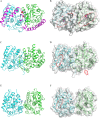Crystal structure of PMGL2 esterase from the hormone-sensitive lipase family with GCSAG motif around the catalytic serine
- PMID: 31990908
- PMCID: PMC6986724
- DOI: 10.1371/journal.pone.0226838
Crystal structure of PMGL2 esterase from the hormone-sensitive lipase family with GCSAG motif around the catalytic serine
Abstract
Lipases comprise a large class of hydrolytic enzymes which catalyze the cleavage of the ester bonds in triacylglycerols and find numerous biotechnological applications. Previously, we have cloned the gene coding for a novel esterase PMGL2 from a Siberian permafrost metagenomic DNA library. We have determined the 3D structure of PMGL2 which belongs to the hormone-sensitive lipase (HSL) family and contains a new variant of the active site motif, GCSAG. Similar to many other HSLs, PMGL2 forms dimers in solution and in the crystal. Our results demonstrated that PMGL2 and structurally characterized members of the GTSAG motif subfamily possess a common dimerization interface that significantly differs from that of members of the GDSAG subfamily of known structure. Moreover, PMGL2 had a unique organization of the active site cavity with significantly different topology compared to the other lipolytic enzymes from the HSL family with known structure including the distinct orientation of the active site entrances within the dimer and about four times larger size of the active site cavity. To study the role of the cysteine residue in GCSAG motif of PMGL2, the catalytic properties and structure of its double C173T/C202S mutant were examined and found to be very similar to the wild type protein. The presence of the bound PEG molecule in the active site of the mutant form allowed for precise mapping of the amino acid residues forming the substrate cavity.
Conflict of interest statement
The authors have declared that no competing interests exist.
Figures





Similar articles
-
Effect of Cysteine Residue Substitution in the GCSAG Motif of the PMGL2 Esterase Active Site on the Enzyme Properties.Biochemistry (Mosc). 2020 Jun;85(6):709-716. doi: 10.1134/S0006297920060085. Biochemistry (Mosc). 2020. PMID: 32586234
-
Expression and characterization of a new esterase with GCSAG motif from a permafrost metagenomic library.FEMS Microbiol Ecol. 2016 May;92(5):fiw046. doi: 10.1093/femsec/fiw046. Epub 2016 Feb 28. FEMS Microbiol Ecol. 2016. PMID: 26929439
-
Structural basis for dimerization and catalysis of a novel esterase from the GTSAG motif subfamily of the bacterial hormone-sensitive lipase family.J Biol Chem. 2014 Jul 4;289(27):19031-41. doi: 10.1074/jbc.M114.574913. Epub 2014 May 27. J Biol Chem. 2014. PMID: 24867954 Free PMC article.
-
Bacterial Hormone-Sensitive Lipases (bHSLs): Emerging Enzymes for Biotechnological Applications.J Microbiol Biotechnol. 2017 Nov 28;27(11):1907-1915. doi: 10.4014/jmb.1708.08004. J Microbiol Biotechnol. 2017. PMID: 29032653 Review.
-
GDSL family of serine esterases/lipases.Prog Lipid Res. 2004 Nov;43(6):534-52. doi: 10.1016/j.plipres.2004.09.002. Prog Lipid Res. 2004. PMID: 15522763 Review.
Cited by
-
Biochemical and Structural Characterization of a novel thermophilic esterase EstD11 provide catalytic insights for the HSL family.Comput Struct Biotechnol J. 2021 Feb 10;19:1214-1232. doi: 10.1016/j.csbj.2021.01.047. eCollection 2021. Comput Struct Biotechnol J. 2021. PMID: 33680362 Free PMC article.
-
Transcriptome-Based Identification of a Functional Fasciola hepatica Carboxylesterase B.Pathogens. 2021 Nov 10;10(11):1454. doi: 10.3390/pathogens10111454. Pathogens. 2021. PMID: 34832612 Free PMC article.
-
A Single Nucleotide Polymorphism Translates into a Radical Amino Acid Substitution at the Ligand-Binding Site in Fasciola hepatica Carboxylesterase B.Genes (Basel). 2022 Oct 19;13(10):1899. doi: 10.3390/genes13101899. Genes (Basel). 2022. PMID: 36292784 Free PMC article.
-
Engineering of Thermal Stability in a Cold-Active Oligo-1,6-Glucosidase from Exiguobacterium sibiricum with Unusual Amino Acid Content.Biomolecules. 2021 Aug 17;11(8):1229. doi: 10.3390/biom11081229. Biomolecules. 2021. PMID: 34439895 Free PMC article.
-
Structural and Biochemical Characterization of a Cold-Active PMGL3 Esterase with Unusual Oligomeric Structure.Biomolecules. 2021 Jan 5;11(1):57. doi: 10.3390/biom11010057. Biomolecules. 2021. PMID: 33466452 Free PMC article.
References
-
- Kumar L, Awasthi G, Singh B. Extremophiles: a novel source of industrially important enzymes. Biotechnology. 2011;10(2):121–35.
Publication types
MeSH terms
Substances
LinkOut - more resources
Full Text Sources

